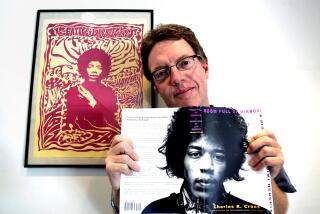The king of the inkies
London — “It’s our job to serve the lives of music fans,” enthuses Conor McNicholas, editor of the NME, last survivor of Britain’s once-thriving weekly pop newspaper scene. “What they want to do is get close to the bands, hang out with the artists they love.”
It’s crucial to the recent renaissance in a publication many thought doomed by the new millennium that McNicholas’ fresh young team of reporters has shown the will, the instinct and the sheer 24-hour energy to create that exhilarating illusion.
For instance, NME’s Marc Hayward was the only journalist outside London’s Wandsworth prison at the crack of dawn awaiting key British band the Libertines’ Pete Doherty on his release last fall after a month inside for burgling his bandmate Carl Barat’s flat -- an offense that, along with Doherty’s acknowledged crack and heroin addictions, had seen him thrown out of the band.
So he was on the spot when Barat turned up, flung his arms around Doherty and welcomed him back into the band. Result: an NME exclusive on the year’s most dramatic story in British music.
“Just good journalism,” says the editor, proud to discuss his NME (formerly New Musical Express) in the context of the grand and nefarious history of the “inkies” -- the British pop weeklies so called because their scruffy newsprint left a black mark on every reader. “After all, we were there from day one of pop culture.”
Ride the elevator to the 26th floor of a Thames-side office block and sit in on a solid, businesslike editorial meeting and you would hardly feel the pulse of the rock ‘n’ roll lifestyle. But then it did all begin with the proprieties of an era before youth was invented.
The original pop inkie, Melody Maker, launched in 1925 with a front-page splash headed “The Banjo in the Modern Dance Orchestra.” Little had changed by 1951 when NME started life as the Musical & Accordion Express.
But the coming of Elvis, the Beatles and Dylan saw the bereted and bearded gentlemen of the old school pensioned off in favor of hairy, politicized novices from the underground press.
By the mid-’70s there were five weekly titles: NME, Melody Maker, Sounds, Disc and Record Mirror. The NME usually led the way with sales often above 250,000 and well over a million readers. Its writers could become stars in their own right.
Notoriously, the revered Nick Kent lived the life and looked the part so convincingly that when he sat in a New York restaurant with Lou Reed and David Bowie, he was the one the waitress asked for an autograph.
In Paul Gorman’s oral history of the music press, “In Their Own Write,” Kent’s peer in this ramshackle royalty, Charles Shaar Murray, recalls that accepting a minor assignment to review “some dodgy combo” could quickly translate into “a press officer flying you to Amsterdam, buying you a stupefyingly expensive dinner, taking you on a tour of the red-light district and uncomplainingly parting with corporate wedge to buy you a wrap of over-priced cocaine. Then you’d go home, slide behind the typewriter for 15 minutes and slag the band off. Oh how we laughed!”
Publication evolution
After the ‘70s, the inkies began a long, slow decline, largely because the music market became overcrowded as magazine publishers launched glossy monthlies such as Q and Mojo while national newspapers and television also realized what a selling point rock and pop could be.
Despite coarse eruptions such as grunge and Britpop, overall the mass media’s flabby embrace neutralized teens’ and twentysomethings’ sense of “owning” the music, the culture. When Melody Maker closed down at the end of 2000, NME stood alone, forlorn as the last dodo. Circulation sagged below 70,000. Extinction loomed.
While NME’s obsequies were still being rehearsed, the first hint of redemption arrived. In 2001, the magazine, owned by the British magazine publisher IPC Media, a division of Time Warner, hit on the Strokes and the White Stripes before the U.S. did.
Then, calling out around the world, it was the Vines from Australia, the Hives from Sweden, the Datsuns from New Zealand, and NME’s reputation for talent-spotting, for starting something, was partly restored. But somehow it wasn’t finding new readers.
So when McNicholas moved from dance music magazines to take over in 2002, he “tried to get inside the mind of the reader” (the stats say they’re 80% students, 70% male). Getting the look right was the easy part: glossy cover and full-color poster pull-out, a plain, breathlessly speedy feel to the editorial pages with all-color pics presented as decently as feasible on newsprint.
The writing had long since left behind the pretentious intellectualism and put-down snobbery that scarred the NME’s ‘80s -- the days when teenagers had to know what solipsisms and zeitgeists were before they were allowed to raaaack.
McNicholas’ general influence can be felt in the straightforward enthusiasm and inclusiveness of the current team’s style. Also, contrary to British publishers’ down-dumbing tendencies, he actually lengthened the main features.
But the crunch issue for any cultural magazine exposed to the white heat of contemporary fashion is, simply, what to cover -- hitting the topics that grab the readers.
McNicholas studied NME’s history and decided that one constant should be a weave of back-reference to the enduring heroes of rock who were always touching new young fans: the Who, the Sex Pistols, Morrissey, Nirvana. And he did have one solid piece of luck: British music, stirred up by all those foreigners, started to return to NME’s bedrock boys-with-guitars ethos.
Suddenly the Libertines emerged -- a band born to be his readers’ friends.
Just back off the road with them, writer Mark Beaumont -- one of the paper’s 28 editorial staffers -- knows exactly why they are the core NME band of the moment: “They shout fast, catchy pop songs about living in grotty squats and they make that -- the normal life of a lot of these kids -- sound aspirational absolutely sensational. They celebrate their fans. And the imprisonment and the reunion galvanized their support. This tour has made them a phenomenon. It’s a godsend for a music writer. You unleash your pen ...”
‘Guerrilla warfare’
It’s the story of Glasgow arty-pop band Franz Ferdinand that represents McNicholas’ ideal blueprint for NME: getting close to a band from birth to chart.
Utterly unknown, the band sent new-music editor Imran Ahmed a rough demo tape just over a year ago. From that moment, NME was first at every stage of its development -- gig reviews, interviews, singles reviews, and finally a cover story in January just before its album came out.
Franz Ferdinand publicist Steve Phillips says NME’s revived influence in media circles worked wonders: “The cover was a fantastic catalyst to persuade radio and TV to give Franz the thumbs-up. NME carries a lot of weight.”
Rolling Stone may once have had that weight in the U.S., back in the ‘60s and ‘70s when it pretty much had the field to itself and when being on the cover was a badge of honor. But no U.S. pop magazine now delivers fans the way NME does, partly because it doesn’t champion a band relentlessly, week after week, virtually forcing readers into submission.
(Not every NME pick has ended up clicking. A list of post-1990 fizzles includes Baby Amphetamines, June Brides and Shampoo.)
If Franz Ferdinand’s progress to an instant Top 5 album was happily symbiotic for industry, fans and magazine, McNicholas is adamant that NME thrives on elbowing PR aside -- as illustrated by its boisterous relationship with the Darkness, the biggest new band in Britain. Last year, it took umbrage at NME sarcasm and withdrew “cooperation” last year and refused to talk to the magazine.
Pragmatic McNicholas sought out lead singer Justin Hawkins, who suggested he get down on his knees and beg. McNicholas did it. Hawkins told him to buzz off and banned the NME from Darkness gigs too. So NME put it on the cover, having penetrated the security net on their debut New York gig for an eyewitness report and pictures.
“It’s guerrilla warfare with some of these bands,” McNicholas says, rather gleefully.
It’s plainly a good moment for the NME with new bands going off like firecrackers -- watch out for Glitterati, the Open, the Ordinary Boys -- but gung-ho as the editor seems, the arguably anachronistic weekly’s problems remain.
Sales can go up only so much
If fashion swings away from his guitar bands before they cohere into a durable movement and back toward nu metal, glossy specialist weekly Kerrang! is ready to overtake NME again, as it did a couple of years ago. And then McNicholas has to carry out his plan for reacting to the way downloads have crushed the British singles market.
And try to persuade more of nme.com’s million users to buy the earthy, inky real thing too.
He claims, “Our influence is probably greater than ever.” Maybe so. Lone survivor status has its advantages. But while handily lowering average reader age from 27 to 23, the parameters have shifted so much that NME’s energy surge has lifted sales to only 72,000, and marketing manager Nick New’s best prognostication is 100,000 in five years.
Still, almost everybody wishes it well.
Ted Cummins, Britain’s director of press for Island Records, says: “It would be tragic for the music business if NME closed, because it has an independent spirit, and what readers look for in a magazine is insight and integrity, not the voice of PR. They must feel, ‘This is the magazine that drives my life.’ ”
McNicholas knows it. “The dance club culture I used to work in eventually died because -- take all the drugs you like, at the end of the day there’s nothing there -- it doesn’t mean anything,” he says. “Rock ‘n’ roll means something because Jimi Hendrix died and Kurt Cobain died, because of Woodstock and the Isle of Wight Festival and the Sex Pistols. Our readers don’t want vacuous good-looking guys playing pretty tunes. Coldplay and Radiohead are eternal favorites with them because their music touches you, it’s there for a reason, it has depth.”
Phil Sutcliffe is a London-based writer.
More to Read
The biggest entertainment stories
Get our big stories about Hollywood, film, television, music, arts, culture and more right in your inbox as soon as they publish.
You may occasionally receive promotional content from the Los Angeles Times.










